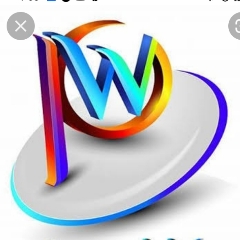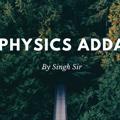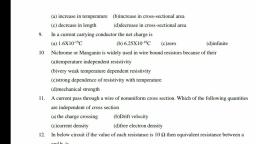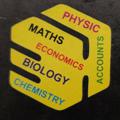Question 4 :
If the emf of the cell in the primary circuit is doubled, with out changing the cell in the secondary circuit, the balancing length is<br/>
Question 5 :
Two resistances 6 and 12 ohms are connected in parallel to a battery of 10 volts. The current in amperes in 12 ohm resistor is<br/>
Question 7 :
Which of the following is not true for wire wound resistor?
Question 8 :
Kirchoff's first law, i.e., $\sum i = 0$ at a junction, deals with the conservation of
Question 9 :
If n resistance (each R) are connected in series then their resultant will be
Question 10 :
When the length of a wire is doubled, the specific resistance of the material of the wire becomes
Question 12 :
Between any two points in a circuit, the sum of all .............. is the same through any pathway.<br>
Question 13 :
A solid spherical non-conductor of radius<b> 5 cm</b> has the potential of <b>50 V</b> at its outer surface. The potential atits center is
Question 14 :
Consider the following two statements:<br>(A) Kirchhoff's Junction Law follows from conservation of charge.<br>(B) Kirchhoff's Loop Law follows from conservative nature of electric field.<br>
Question 15 :
If the length of a material changes 4 times and area changes 2 times. Then the resistivity of the material will be changing
Question 17 :
For a metallic wire, the ratio $\displaystyle \frac{V}{i}$ (where, V = applied potential difference and i = current flowing)
Question 18 :
A circuit is made from two resistors in series and a battery. As more resistors are added in series, how is the current coming out of the battery affected?
Question 19 :
What is the power produced by an appliance marked " $240 V$, $2 A?$
Question 20 :
A battery of $9V$ is connected in series with resistors of $0.5, 0.3, 0.4, 0.2$, and $12$. How much current would now through the $0.4$ resistors?
Question 21 :
Which of the following is not the disadvantage of wire wound resistor?
Question 22 :
A room has AC run hours a day at a voltage of $220$V. The wirng of the room consists of Cu of $1$mm radius and a length of $10$m. Power consumption per day is $10$ commercial units . The fraction of it goes in the joule heating in wires is: $\rho_{cu}=1.7\times10^{-8}\Omega m$
Question 23 :
Appropriate material to be used in the construction of resistance boxes out of the following is
Question 24 :
If the temperature of a conductor is increased, its resistance will<br><br>
Question 25 :
State whether True or False<br/>It is possible that a battery has some constant value of emf but the potential difference between the plates is zero.
Question 27 :
When n number identical cell of emf E and internal resistanceis connected in parallel, the net emf of the system will be <br>
Question 30 :
A 60 watt bulb carries a current of 5A . Find the total charge passing through it in 1 hour.
Question 31 :
The potential gradient along the length of a uniform wire is $10$ volt/m B and C are two points at $30$ cm and $60$ cm in a scale fitted along the wire. The pd between B and C is<br>
Question 34 :
On which one of the following the emf of a cell does not depend : 
Question 35 :
Assertion (A) :Parallel connection of cells is preferred to draw more current at low potential difference.<br/>.<br/>Reason (R) :In parallel connection, current i$=\frac{ne}{r}$ if r>> R.<br/><br/>
Question 36 :
Two bulbs, one of 50 W and another of 25 W, are connected in series to the mains. The current flowing through them will be in the ratio
Question 37 :
A wire of uniform cross-section has a resistance of $R \ \ \Omega$. What would be the resistance of a similar wire, made of the same material, but twice as long and of twice the diameter?
Question 38 :
An electric iron is connected to the 230 V mainssupply. A current of 8 A flows through the iron. How much energy is transferred to the heater eachsecond?
Question 40 :
Amount of electric energy consumed in a circuit per unit time is.
Question 42 :
A potentiometer has a driving cell of negligible internal resistance. The balancing length of a Daniel cell is 5 m. If the driving cell had internal resistance, the balancing length of the same Daniel cell would have been
Question 43 :
Two wires of the same dimensions but resistivities $p_1$ and $p_2$ are connected in series.The equivalent resistivity of the combination is
Question 44 :
Which among the following is the commercial unit of electric power?
Question 45 :
Which physical quantity cannot be determined with the help of potentiometer?<br>
Question 46 :
The resistance of a semiconductor material (germanium or silicon)_______ with rise in temperature.
Question 47 :
A bulb of$\displaystyle 22\Omega$ is producing light when connected to 220V supply. What is the electric power of the bulb.
Question 49 :
Rate at which electric work is done is called as ?<br/>
Question 50 :
The color coding of  earth, live and neutral wire respectively is<br/>
Question 51 :
For a cell terminal P.D. is 2.2 V when circuit isopen and reduces to 1.8 V when cell is connectedto a resistance of R = 5. Determine internalresistance of cell (r) is then : -
Question 52 :
Potentiometer is a type of instrument by which potential difference can be measured
Question 53 :
At $100^oC$, resistance of a conducting coil is $4.2\Omega$. If the temperature coefficient of resistance is $0.004^oC$, what will be the resistance of $0^oC$? (in ohm)
Question 54 :
Anexternal resistance R is connected to a cell ofinternal resistance r. The largest amount ofcurrent flows in the external resistance, when<br>
Question 56 :
The current carrying wire and the rod $AB$ are in the same plane. The rod moves parallel to the wire with a velocity $v$. Which one of the following statement is true about induced e.m.f. in the rod?
Question 57 :
$12$ cells each of e.m.f $2V$ are connected in series among them, if $3$ cells are connected wrongly. Then be effective e.m.f. of the combination is:
Question 58 :
A constant voltage power source is connected to a resistor in an electric circuit .The resistance is increased by four times. Identify the changes in voltage of power source .
Question 59 :
In an experiment of Wheatstone bridge, if the positions of cells and galvanometer are interchanged, then the balance points will
Question 61 :
A length of $150\ cm$ of a potentiometer wire is required to balance the emf of a cell. When a $5 \Omega$ resistor is connected across the terminals of the cell, the length required for balance is $125\ cm$. The internal resistance of the cell is
Question 62 :
A cell of internal resistance $r$ is connected to an external resistance $R$. The current will be maximum in $R,$ if
Question 63 :
Assertion: If the length of the conductor is doubled, the drift velocity will become half of the original value (keeping potential difference unchanged).
Reason: At constant potential difference, drift velocity is inversely proportional to the length of the conductor.
Question 64 :
If the resistance is connected acorss the cell e, the balancing length will
Question 65 :
A cell of emf e$_{1}$ in the secondary circuit gives null deflection for 1.5m length of potentiometer of wire length 10m. If another cell of emf e$_{2}$ is connected in series with e$_{1}$then null deflection was obtained for 2.5 m length. Then e$_{1}$: e$_{2}$ is: <br/>
Question 66 :
A battery of e.m.f 15 V and internal resistance 3 ohm is connected to two resistors of resistances 3 ohm and 6 ohm in series.  The p.d between the terminals of the battery is
Question 68 :
In a meter bridge experiment, the ratio of the left gap resistance to right gap resistance is $2 : 3$, the balance point from left is?
Question 69 :
Which of the following characteristics of electrons determines the current in a conductor?
Question 70 :
Which of the following statements are wrong w.r.t the specific resistance of wire?
Question 71 :
A cell of emf $E$ volts with no internal resistance is connected to a wire of uneven cross-sectional area. The wire has three sections of equal length. The radius of the middle section is $a$ and the other are $2 a$. The ratio of the potential difference across the middle section to any other section is 
Question 72 :
Kirchhoff's first law, i.e., $\sum I= 0$ at a junction, deals with the conservation of
Question 73 :
The temperature coefficient of resistance of conductor varies as $\alpha (T)=3T^2+2T$. If $R_0$ is resistance at $T = 0$ and $R$ is resistance at $T$, then<br>
Question 75 :
Two resistors $R_1 \, (24 \pm 0.5) \Omega$ and $R-2 \, (8 \pm 0.3) \Omega$ are joined in series. The equivalent resistance is
Question 76 :
A wire has a diameter of $0.2  mm$ and a length of $50  cm$. The specific resistance of it's material is $40\times 10^{-6}$ <br> $ohm  cm$. The current through it, when a potential difference of $2  V$ is applied across it, is<br/>
Question 77 :
The belt of an electrostatic generator is 50 cm wide and travels at 30 cm/sec. The belt carries into the sphere at a rate corresponding to $10^{-4}$ ampere. What is the surface density of charge on the belt.
Question 78 :
When the resistance of $9\Omega$ is connected at the ends of a battery, its potential difference decreases from $40$ volt to $30$ volt. The internal resistance of the battery is
Question 79 :
There is a current of 1.344 amp in a copper wire whose area of cross-section normal to the length of the wire is $ 1 mm^2 $. If the number of free electrons per $ cm^3 is 8.4 \times 10^{22} $, then the drift velocity would be
Question 80 :
For a given cell, its terminal voltage depends on ____ and _______.<br/>
Question 81 :
A wire of length $L$ and 3 identical cells of negligible internal resistances are connected in series. Due to the current, the temperature of the wire is raised at $\triangle T$ in time $t$. $N$ number of similar cells is now connected in series with a wire of the same material and cross-section but of length $2L$. The temperature of the wire is raised by the same amount $\triangle T$ in the same time $t$. The value of $N$ is:
Question 82 :
Charge carriers, each of charge q, move along a wire of fixed length. The number density of the<br>charge carriers in the wire is n.<br>What is also required, for this wire, to determine the average drift velocity of the charge carriers in<br>terms of n and q?
Question 83 :
If six identical cells each having an e.m.f. of $6\ V$ are connected in parallel, the e.m.f. of the combination is
Question 84 :
A potential difference of $2 V$ exists across a potentiometer wire of $2 m$ length. When the potential difference across a $2\Omega $ resistance of a second circuit is measured by the potentiometer wire, it amounts to $5 mm$ balancing length. The current in the second circuit is <br/>
Question 85 :
A cell of E.M.F. E and internal resistance r supplies currents for the same time t through external resistance$R_1$ and $R_2$ respectively. If the heat produced in both cases is the same then the internal resistance is
Question 86 :
When a battery connected across a resistor of $\displaystyle 16\Omega $, voltage across the resistor is 12V. When the same battery is connected across a resistor of $\displaystyle 10\Omega $, voltage across it is 11 V. The internal resistance of the battery (in ohm) is :<br/>
Question 87 :
Twelve cells, each having an e.m.f of  E volt are connected in series and are kept in a closed box. Some of these cells are wrongly connected with positive and negative terminals reversed. This 12 cell battery is connected in series with an ammeter, an external resistance R ohms and a two-cell battery (two cells of the same type used earlier, connected perfectly in series). The current in the circuit when the 12-cell battery and 2-cell battery aid each other is 3A and is 2A when they oppose each other. Then the number of cells in 12-cells battery that are connected wrongly is:<br/>
Question 88 :
A bulb having voltage rating $V$ and power rating $W$ is supplied with current from $n$ cells each of $1.5\ Volt$ and internal resistance $r$. The value of $n$ to run lamp at rated power $W$ is
Question 89 :
The temperature coefficient of resistance of a wire is $0.00125$ per $^{0}C$. At $300 K$, its resistance is $1 ohm$. This resistance of the wire will be $2 ohm$ at       
Question 90 :
When a current $I$ is set up in a wire of radius $r,$ the drift velocity is $v_d$. If the same current is set up through a wire of radius $2 r,$ the drift velocity will be
Question 91 :
There is a current of 40 amperes in a wire of $10^{-16}m^{2}$ area of cross-section. If the number of free electrons per $m^{3}$ is $10^{29}$, then the drift velocity will be:
Question 92 :
The potential difference in open circuit for a cell is $2.2\ V$. When a$\displaystyle 4\Omega$ resistor is connected between its two electrodes the potential difference becomes $2\ V$. The internal resistance of the cell will be
Question 93 :
Current in a circuit falls from $5.0$A to $0.0$A in $0.1$S. If an average emf of $200$V induced, given an estimate of the self-inductance of the circuit.
Question 94 :
When a battery connected across a resistor of 16$\Omega $ , the voltage across the resistor is 12 V. When the same battery is connected across a resistor of  10$\Omega $ , voltage across it is 11V. The internal resistance of the battery in Ohms is<br/>
Question 95 :
The resistivity of steel wire is $1\times { 10 }^{ -7 }\Omega -m$. The resistance of a steel wire of particular length and thickness is $1\Omega $. If the length and the diameter of the wire both are doubled, then the resistivity in $\Omega -m$ will be
Question 96 :
A battery of emf $2$ volt and internal resistance $0.1$ ohm is being charged with a current of $5$ ampere. The potential difference between the two terminals of the batteries is <br/>
Question 98 :
To get maximum current in a resistance of $3\Omega$, one can use n rows of m cells (connected in series) connected in parallel. If the total number of cells is 24 and the internal resistance of a cell is $0.5\Omega$, then<br>
Question 99 :
In a potention meter of one metre length an unknown emf voltage source is balanced at 60 cm length of potention meter wire, while a 3v battery is balanced at 45 cm length. Then, the emf of the unknown voltage source is :
Question 101 :
Estimate the average drift speed of conduction electrons in a copper wire of cross-sectional area $\displaystyle 1.0\times { 10 }^{ -7 }{ m }^{ 2 }$ carrying a current of $1.5\ A$. Assume that each copper atom contributes roughly one conduction electron. The density of copper is $\displaystyle 9.0\times { 10 }^{ 3 }{ kgm }^{- 3 }$ and its atomic mass is $63.5\ amu$.
Question 102 :
Drift velocity varies with the intensity of electric field as per the relation
Question 103 :
The temperature co-efficient of resistance of a wire is $0.0012/^{\circ}C$. Its resistance is $1\Omega$ at $300\ K$. At what temperature, its resistance will be $2\Omega$?
Question 104 :
A current of $I$ ampere flows through a resistance $R$ when connected across a cell of emf $E$ and internal resistance $1 \Omega$. When $R$ is increased by $50\%$, the current through the circuit is $0.8 A$. The value of $R$ is :
Question 105 :
A cell of emf $E$ is connected to a resistance ${R}_{1}$ for time $t$ and the amount of heat generated in it is $H$. If the resistance ${R}_{1}$ is replaced by another resistance ${R}_{2}$ and is connected to the cell for the same time $t$, the amount of heat generated in ${R}_{2}$ is $4H$. Then internal resistance of the cell is:
Question 106 :
In a Wheatstone bridge, three resistances P, Q and R are connected in the three arms and the fourth arm is formed by two resistances $S_1$ and $S_2$ connected in parallel. The condition for the bridge to be balanced will be
Question 107 :
A material $B$ has twice the specific resistance of $A$. A circular wire made of $B$ has twice the diameter of a wire made of $A$. Then for the two wires to have the same resistance, the ratio $l_{B} $ / $l_{A}$ of their respective lengths must be:
Question 108 :
A copper tube is of internal radius 4 mm and outer radius 5 mm. Its resistance is R$_{1}$. The tube is filled with a suitable copper wire. The resistance of the arrangement is R$_{2}$.Then R$_{2}$/R$_{1}$ is<br>
Question 109 :
Two metallic wires $A$ and $B$ of equal dimensions but made of different materials, having resistivities $\rho$ and $2\rho$, temperature coefficients of resistivities $2\alpha$ and $\alpha$ are connected in series. The temperature coefficient of resistance of the composite wire equals:
Question 110 :
Two parallel straight conductors carrying currents 5A each repel other with a force of $25 \times 10^{-5} Nm^{-1}$. The distance between the conductors is
Question 112 :
A 50 V d.c power supply is used to charge a battery of eight lead accumulators, each of emf 2 V and internal resistance $1/8 \Omega$. The charging current also runs a motor connected in series with the battery. The resistance of the motor is $5 \Omega$ and the steady current supply is 4 A. The chemical power stored in the battery is
Question 113 :
Three conductors draw currents of 1 A, 2 A and 4 A respectively, when connected independently across an ideal battery. If they are connected in series across the same battery, then the current drawn will be:<br/>
Question 114 :
<br/>A cell of constant emf first connect to a resistance $R_1$ and then to connected to the resistance $R_2.$ If power delivered in both cases in the same then internal resistance of the cell
Question 115 :
A counter consists of a cylindrical cathode of radius $1 cm$ and an anode wire of radius $0.01 cm$ which is placed along the axis of the cathode. A voltage of $2.3 kV$  is applied between the cathode and anode. The electric field on the anode surface must be :<br/>
Question 116 :
Three resistors are connected in parallel across a potential difference and a current $I$ passes through it, the resistance values are such that $R_1 < R_2 < R_3$, then the ratio of branch currents in the same order is:
Question 119 :
A current source drives a current in a coil of resistance $R_1$ for a time $t$. The same source drives current in another coil of resistance $R_2$ for same time. If heat generated is same, find internal resistance of source.
Question 120 :
A dynamo develops $0.5 A$ at $6 V$, the power delivered is ______.
Question 121 :
A current of $16 \ A$ is made to pass through a conductor in which the number density of free electrons is $\displaystyle 4\times { 10 }^{ 28 }{ m }^{ -3 }$ and its area of cross section is $\displaystyle { 10 }^{ -5 }{ m }^{ 2 }$. The average drift velocity of free electrons in the conductor is:
Question 122 :
A voltmeter and an ammeter are connected in series to an ideal cell of emf E. The voltmeter reading is V and the ammeter reading is l<br>
Question 124 :
A potentiometer wire of length $L$ and a resistance $r$ are connected in series with a battery of e.m.f. $E_0$ and a resistance $r_1$. An unknown e.m.f. $E$ is balanced at a length $l$ of the potentiometer wire. The e.m.f. $E$ will be given by:
Question 125 :
An ionization chamber with parallel conducting plates as anode and cathode, has $5\times 10^{7}$electrons and the same number of singly charged positive ions per $cm^{3}$. The electrons are moving towards the anode with velocity $0.4\ m/s$. Thecurrent density from anode to cathode is $4\mu A/m^{2}$. The velocity of positive ions moving towards cathode is
Question 127 :
If two resistors of resistance 30 $\Omega$ and 40 $\Omega$ are connected in parallel across a battery. The ratio of the potential difference across them is _____.
Question 129 :
A battery is delivering same power to resistance $R_1$ and $R_2$ . Then find the internal resistance of battery :<br>
Question 130 :
A copper wire of $3\ mm^{2}$ cross sectional area carries a current of $5\ ampere$. The magnitude of the drifty velocity for the electrons in the wire, (Assume copper to be monovalent, $M_{Cu} = 63.5\ kg/k\ mol$ and density of copper $= 8920\ kg/m^{3})$.
Question 132 :
The length of potentiometer wire is 10 m and is connected inseries with an accumulator. The e.m.f. of a cell balances against 250 cm length of wire. If the length of potentiometer wire is increased by 1m, calculate the new balancing length of wire.
Question 133 :
<p>Copper has one conduction electron per atom. Its density is $8.89{ g }/{ m^3}$ and its atomic mass is 63.54 g/mol. lf a copper wire of diameter 1.0 mm carries a current of 2.0 A. What is the drift speed of the electrons in the wire?</p>
Question 134 :
In a potentiometer experiment, it is found that no current passes through the galvanometer when the terminals of the cell are connected across $52$cm of the potentiometer wire. If the cell is shunted by a resistance of $5\Omega$, a balance is found when the cell is connected across $40$cm of the wire. Find the internal resistance of the cell.
Question 135 :
The magnitude of electric field at different points along the length of the rod is given by
Question 136 :
The Kirchhoff's first law $(\displaystyle\sum i=0)$ and second law $\left(\displaystyle \sum iR=\displaystyle\sum E\right)$, where the symbols have their usual meanings, are respectively based on
Question 137 :
<p>A potentiometer wire has length $4$m and resistance $8\Omega$.What should be the resistance that must be connected in series with the wire and an accumulator of emf $2$V, so as to get a potential gradient $1$mV per cm on the wire?</p>
Question 138 :
You are given $5   m$ length of heating wire, it has resistance of $24   \Omega$. It is cut into two and connected to $110$ volt line individually. The total power for the two half lengths is:
Question 139 :
There are a large number of cells available, each marked $(6\ V, 0.5\Omega)$ to be used to supply current to a device of resistance $0.75\Omega$, requiring $24A$ current. How should the cells be arranged, so that power is transmitted to the load using minimum number of cells?
Question 140 :
Two heater coils separately take $10$ minute and $5$ minute to boil certain amount of water. If both the coils are connected in series, the time taken will be
Question 141 :
The equivalent resistance of eight equal resistances in series is $48$ ohms. What would be the equivalent resistance if they are connected in parallel?
Question 142 :
The supply voltage to a room is 120 $V$. The resistance of the lead wires is 6 $\Omega$. A $60W , 120V$ bulb is already switched on. What is the decrease of voltage (in Volts )across the bulb, when a $240 W , 120 V $heater is switched on in parallel to the bulb?<br>
Question 143 :
Every atom makes one free electron in copper. If $1.1$ ampere current is flowing in the wire of copper having 1mm diameter, then the drift velocity (approx) will be (density of copper = $9 \times 10^3 kg/m^3$ and atomic weight of copper = $63$)<br>
Question 144 :
Three unequal resistance are connected in parallel. Two of these resistances are in the ratio $1 : 2$. The equivalent resistance of these three connected in parallel is $1\Omega$. What is the highest resistance value among these three resistances if no resistance is fractional?
Question 145 :
The temperature coefficient of resistance of a wire is $\displaystyle { 0.00125 }/{ ^{ \circ  }{ C } }$. Its resistance is $\displaystyle 1\Omega $ at $300\ K$. Its resistance will be $\displaystyle 2\ \Omega$ at:
Question 146 :
A constant potential difference is applied between the ends of the wire. If the length of the wire is elongated $4$ times, then the drift velocity of electrons will be:<br/>
Question 148 :
If an alternate current main supply is given to be $220 \ V$. What would be the average electro motive force during a positive half cycle:
Question 149 :
The terminals of a $18 V$ battery with an internal resistance of $1.5 \Omega$ are connected to a circular wire of resistance $24 \Omega$ at two points distant at one quarter of the circumference of a circular wire. The current through the bigger arc of the circle will be
Question 150 :
Assertion: STATEMENT-1 : The current density $\vec{J}$ at any point in ohmic resistor is in direction of electric field $\vec{E}$ at that point.
Reason: STATEMENT-2 : A point charge when released from rest in a region having only electrostatic field always moves along electric lines of force.




























